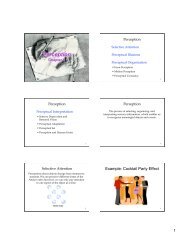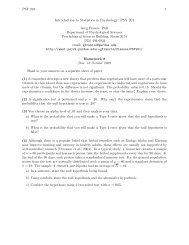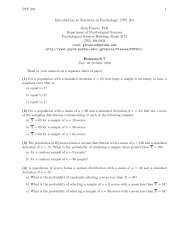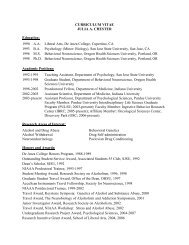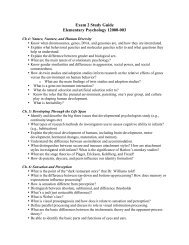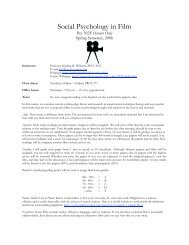Maxims or Myths of Beauty? A Meta-Analytic and Theoretical Review
Maxims or Myths of Beauty? A Meta-Analytic and Theoretical Review
Maxims or Myths of Beauty? A Meta-Analytic and Theoretical Review
You also want an ePaper? Increase the reach of your titles
YUMPU automatically turns print PDFs into web optimized ePapers that Google loves.
Table 8<br />
<strong>Meta</strong>-Analyses <strong>of</strong> Behavi<strong>or</strong>~Traits<br />
MAXIMS OR MYTHS OF BEAUTY<br />
Mdn 95% Fail-safe Homogeneity<br />
Behavi<strong>or</strong>al differences k n d d+ CI N BESD (p)<br />
Child 03 studies) 55 7,384<br />
Adjustment (15 studies) 21 3,876<br />
Intelligence & perf<strong>or</strong>mance (10 studies) 14 3,043<br />
Popularity (15 studies) 30 1,002<br />
Adult (79 studies) 132 13,920<br />
Dating experience (9 studies) 18 1,631<br />
Sexual experience (6 studies) 11 1,678<br />
Extraversion (9 studies) 15 527<br />
Intelligence (t8 studies) 30 3,853<br />
Occupational success (4 studies) 8 3,188<br />
Mental health (19 studies) 30 3,311<br />
Physical health (5 studies) 9 705<br />
Popularity (15 studies) 27 2,983<br />
Self-confidence/esteem (16 studies) 26 1,747<br />
Social skills (18 studies) 20 1,432<br />
Traditional attitudes (4 studies) 7 494<br />
.47 .40* .35/.44 2,145 .19 197.52 (.001)<br />
.27 .32* .25L38 651 .16 41.37(.001)<br />
.32 .39* .32/.47 532 .19 41.13 (.01)<br />
.77 .77* .64/.90 2,280 .36 99.14 (.001)<br />
.38 .40* .37/.44 5,148 .20 1,319.96 (.001)<br />
.59 .55* .45/.65 972 .26 37.78 (.004)<br />
.36 .31" .21/.41 330 .15 19.68 (.05)<br />
.51 .26* .08/.43 375 .13 59.00 (.001)<br />
.13 .07* .01/.14 180 .04 84.54 (.001)<br />
.52 .76* .68/.84 600 .35 708.35 (.001)<br />
.31 .16" .09/.23 450 .08 94.09 (.001)<br />
.43 .38* .24/.53 342 .19 11.09 (.27)<br />
.62 .65* .57L72 1,728 .31 t65.64 (.00)<br />
.24 .24* .151.34 598 .12 57.91 (.002)<br />
.36 .20* .t0/.31 380 .10 56.29 (.002)<br />
.24 .27* .09/.45 182 .13 6.51 (.48)<br />
Note. The sum <strong>of</strong> subcateg<strong>or</strong>y studies does not equal the number <strong>of</strong> studies in the overall categ<strong>or</strong>y because<br />
some studies contributed dependent variables to m<strong>or</strong>e than one subcateg<strong>or</strong>y, k = number <strong>of</strong> independent<br />
samples; d+ = averaged weighted effect size; CI = confidence interval; BESD = binomial effect-size display.<br />
* p < .05.<br />
attractiveness is strongly related to popularity, <strong>and</strong> to success f<strong>or</strong><br />
adults. Attractiveness is moderately related to both intelligence/<br />
perf<strong>or</strong>mance <strong>and</strong> adjustment in children <strong>and</strong> to both dating <strong>and</strong><br />
sexual experience in adults. Interestingly, f<strong>or</strong> children, our findings<br />
f<strong>or</strong> intelligence/perf<strong>or</strong>mance (d+ = .39) c<strong>or</strong>responded closely with<br />
L. A. Jackson et al. (1995), who found an effect size <strong>of</strong> d = .41 f<strong>or</strong><br />
children. Likewise, our near-zero finding f<strong>or</strong> the relation between<br />
intelligence <strong>and</strong> attractiveness in adults is consistent with Feingold<br />
(1992b).<br />
Unlike the overall results f<strong>or</strong> behavi<strong>or</strong>/traits, the effect sizes<br />
f<strong>or</strong> self-perceptions were relatively small. The significantly<br />
smaller overall effect size f<strong>or</strong> self-perceptions relative to be-<br />
havi<strong>or</strong>/traits suggests that unst<strong>and</strong>ardized self-rep<strong>or</strong>ts are not<br />
accurate predict<strong>or</strong>s <strong>of</strong> actual behavi<strong>or</strong>s <strong>and</strong> traits <strong>or</strong> that self-<br />
views are less susceptible to differential judgment <strong>and</strong> treat-<br />
ment than are behavi<strong>or</strong>s. The latter interpretation, if true, sug-<br />
gests that social the<strong>or</strong>y may be inc<strong>or</strong>rect in its prediction that<br />
differential treatment, judgment, <strong>and</strong> behavi<strong>or</strong> eventually be-<br />
come internalized. Alternatively, it may be that the constructs<br />
assessed by current self-perception measures are not as psycho-<br />
metrically sound as they might be.<br />
Table 9<br />
<strong>Meta</strong>-Analyses <strong>of</strong> Adult Self-Perceptions<br />
Familiarity<br />
Additional Moderat<strong>or</strong> Variables<br />
403<br />
To determine whether attractiveness was m<strong>or</strong>e imp<strong>or</strong>tant in<br />
situations in which participants were less rather than m<strong>or</strong>e familiar<br />
with each other, we evaluated the role <strong>of</strong> familiarity as a moderat<strong>or</strong><br />
variable <strong>of</strong> particular interest. Familiarity was coded from 1 (brief<br />
interaction) to 3 (extensive interaction including relationships such<br />
as teacher-child <strong>and</strong> parent-child) <strong>and</strong> entered into the regression<br />
analyses f<strong>or</strong> judgment <strong>and</strong> treatment. In no case was familiarity<br />
significant, suggesting the surprising conclusion that the effects <strong>of</strong><br />
attractiveness are as strong when agents <strong>and</strong> targets know each<br />
other well as when they do not.<br />
Gender <strong>and</strong> Age Effects<br />
When controlling f<strong>or</strong> all variables simultaneously, we found not<br />
a single significant gender effect. The overall lack <strong>of</strong> gender<br />
differences in ecologically valid situations suggests that, in most<br />
domains, attractiveness is equally imp<strong>or</strong>tant f<strong>or</strong> men <strong>and</strong> women.<br />
These findings are consistent with the lack <strong>of</strong> gender differences<br />
Mdn 95% Fail-safe Homogeneity<br />
Adult self-perceptions k n d d+ CI N BESD (p)<br />
Self-perceived traits (16 studies) 23 5,779 .38 .26* .21/.32 598 .13 38.53 (.02)<br />
Competence (10 studies) 12 4,874 .41 .25* .19/.30 476 .12 36.53 (.01)<br />
Mental health (9 studies) 14 4,691 .28 .31" .26/.37 420 .15 11.72 (.63)<br />
Note. The sum <strong>of</strong> subcateg<strong>or</strong>y studies does not equal the number <strong>of</strong> studies in the overall categ<strong>or</strong>y because<br />
some studies contributed dependent variables to m<strong>or</strong>e than one subcateg<strong>or</strong>y, k = number <strong>of</strong> independent<br />
samples; d+ = average weighted effect size; CI = confidence interval; BESD = binomial effect-size display.<br />
*p < .05.


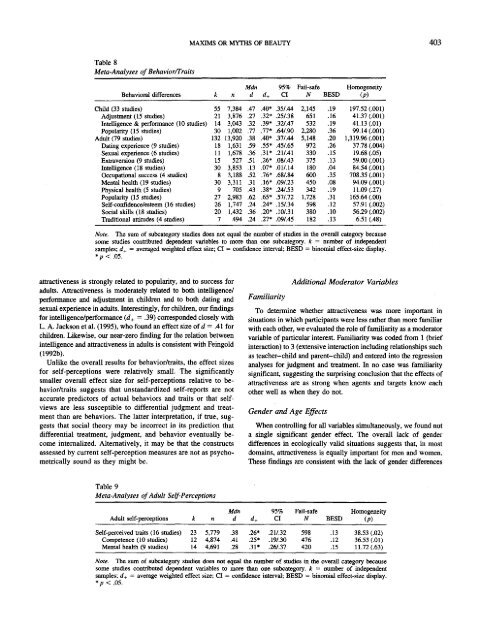
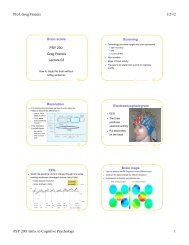

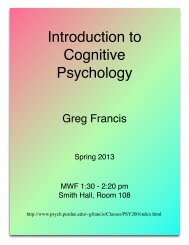
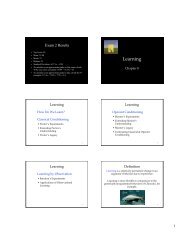
![Exam 4 Study Guide[1]](https://img.yumpu.com/45196739/1/190x245/exam-4-study-guide1.jpg?quality=85)
